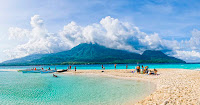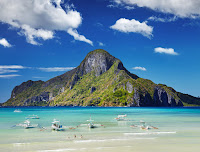El Nido is one of the must-visit and must-return places in the Philippines in 2016. When in El Nido, experience different island hopping tours to white sand beaches, enchanting lagoons, and crystal clear waters, where you can swim, snorkel, do kayaking, or just relax and embrace the hidden beauty of Mother Nature.
Boracay Island, Aklan
 Boracay is probably the most popular beach island in the Philippines. It’s every Filipino’s dream to visit this island located in the province of Aklan. With its soft white sand, bright blue waters, beautiful sunset view, and unforgettable night life experiences
Boracay is probably the most popular beach island in the Philippines. It’s every Filipino’s dream to visit this island located in the province of Aklan. With its soft white sand, bright blue waters, beautiful sunset view, and unforgettable night life experiencesCamiguin Island, Camiguin
 Camiguin province holds the record of having the most number of volcanoes per square kilometer than any other island on the planet. But beyond volcanoes, the province also boasts natural attractions, including an uninhabited white sandbar, hot and cold springs, and waterfalls. Moreover, you can also witness the Lanzones festival in October, visit centuries-old churches, old ancestral homes and the infamous sunken cemetery.
Camiguin province holds the record of having the most number of volcanoes per square kilometer than any other island on the planet. But beyond volcanoes, the province also boasts natural attractions, including an uninhabited white sandbar, hot and cold springs, and waterfalls. Moreover, you can also witness the Lanzones festival in October, visit centuries-old churches, old ancestral homes and the infamous sunken cemetery.Kalanggaman Island, Leyte
The island of Kalanggaman in Palompon has one of the most beautiful sandbars in the Philippines, and probably in the world. No wonder why international cruise ships made a stopover on this dream island to bring hundreds of tourists from the different parts of the world. Swimming in clear and translucent seawaters that glow at night, walking along a white long sandbar.
Puerto Princesa Underground River
 Located on the northern coast of the island of Palawa, Puerto Princesa is a nature lover’s paradise. Home to unspoiled landscapes rich in wildlife, this lovely town also lays claim to one of the world’s most unique natural phenomena, an underground river known as the Puerto Princesa Subterranean River. Protected within a national park, this natural wonder is the world’s longest navigable underground river.
Located on the northern coast of the island of Palawa, Puerto Princesa is a nature lover’s paradise. Home to unspoiled landscapes rich in wildlife, this lovely town also lays claim to one of the world’s most unique natural phenomena, an underground river known as the Puerto Princesa Subterranean River. Protected within a national park, this natural wonder is the world’s longest navigable underground river.
Chocolate Hills
One of the top tourist attractions in the Philippines, The Chocolate Hills are unusual geological formations that consists of at least 1,268 individual mounds scattered throughout the interior of the island of Bohol. The almost symmetrical and same-sized formations range from 98 to 164 feet (30 to 50 meters) high and are covered in green grass. During the dry season the grass turns brow, hence the name. There is no consensus on how these giant mole hills were formed. One theory holds that the Chocolate Hills are the weathered rock formations of a kind of marine limestone on top of an impermeable layer of clay.


